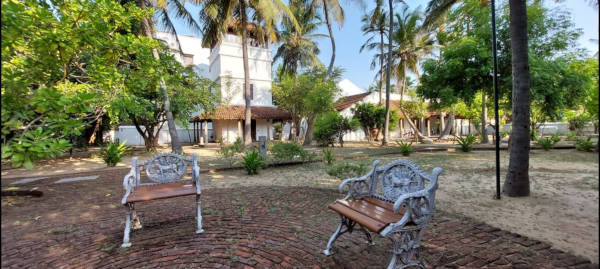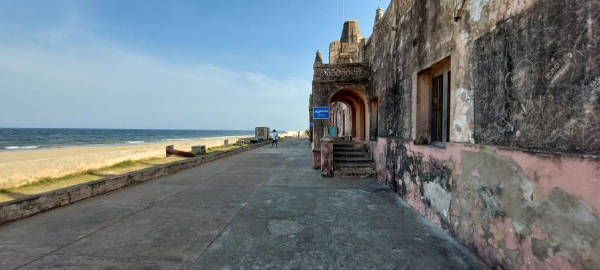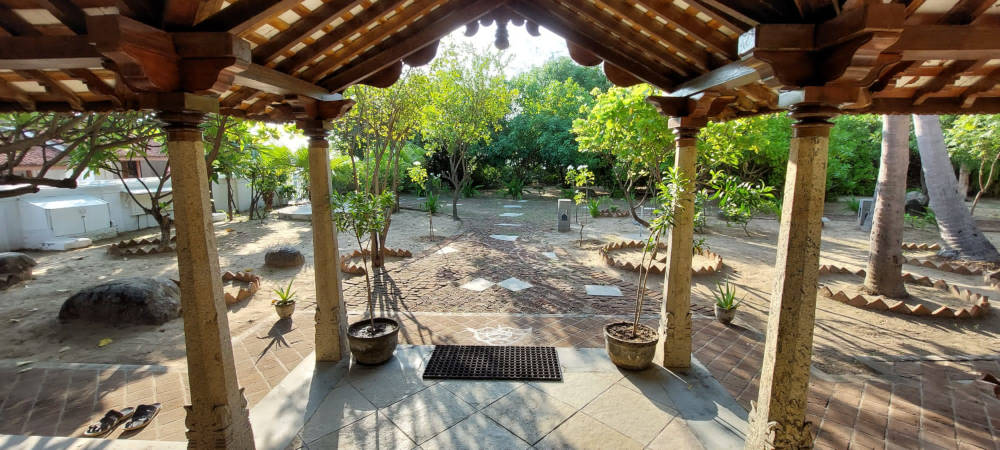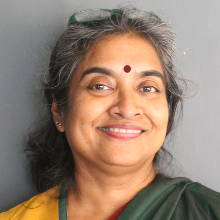(Nayak House homestay at Tranquebar)
Five of us and our bags were packed worse than sardines in a Maruti hatchback on our way further south from Chennai, in Tamil Nadu.
Isha, my daughter, the youngest in the car, said the only bright spot of traveling this way, dysfunctionally together, was getting a chance and being allowed to drive on the excellent highways and coastal roads of the state.
Ashutosh and Shilpa, our friends for over 30 years, had just flown in from Singapore and Mumbai, joining us in our suddenly planned Chola Coromandel trip.
Tamil Nadu to me has always beckoned. Mainly for its people. Things actually get done here. To those of us living North of the Deccan, getting contractors to their jobs comes with in-built delays of weeks. And these delays stretch longer the further North you go in the subcontinent.
Whereas at our little senior living home we had just picked up at Ashiana Shubham in Maraimalai Nagar, a little South of Chennai airport, the interiors chap Giridhar and his assistant Muni were well on their way of completing the modular kitchen, the net doors and windows, fitting the AC and the washing machine, way ahead of schedule.
Unbelievably, we had a week free.
Sridhar, a friend at Chennai, offered his car, and here we were, on the OMR, the Old Mamallapuram Road.
A leisurely lunch followed by a very touristy halt at Chidambaram—a poetry in stone depicting all poses of Bharatnatyam—we finally arrived at the destination Google Maps was so smoothly leading us down to.
Tranquebar.
Away from the hectic pace of our daily lives and our frenetic holidays, the coastal town of Tranquebar in Tamil Nadu is perhaps one of the last few places on the subcontinent that most people have never heard of.

(On the Coromandel coast)
Over 400 years ago, Ove Gjedde, the Danish envoy of the King of Denmark, in exchange for an annual tribute of Rupees three thousand to the Rajah of Tanjore, obtained a sanction for conducting trade with India from Tranquebar.
Standing on the windy coastline today, looking out to the windswept sea dotted with small fishing boats, it is easy to imagine medieval masted ships from Denmark venturing into the break-waters of this ancient Coromandel Port in the Bay of Bengal, back in 1620.
In the following century, there was a time when the Danish and the Swedish East India companies together imported more tea into Europe than did the British. Europeans were on the move. The search for riches and prosperity and the road to India had led Columbus to land in the continent of America. Vasco Da Gama circumnavigated Africa from Portugal, and landed in India.
In those medieval times, European trading ports were peppered all over Southern India.
Nearly a century after the Danish port was established, the German missionary Bartholomaus Zeigenbalg arrived in Tranquebar. This industrious Protestant translated the Bible into Tamil, a language he very quickly picked up. Using the latest and miraculous technology of the Printing Press, soon, Tamil Bibles became prevalent. Much to the dismay of the Italian Catholic priests of the time.
Although evangelical efforts were frowned upon by traders, Tranquebar soon became the space where the Zion Church came up, the very first Protestant church in India.
The old printing press continues to be displayed in a museum housed inside the premises of an all-boys school, and still works—Zeigenbalg's Press churned out this message for us. ‘Keep your distance, it is Covid’.
A brass statue of the missionary dressed in his medieval best has been put up during the ter-centenary or three hundredth year of his arrival. Situated at the intersection of Tranquebar’s main streets and luminously lit up through the night, the long curly haired European keeps a quiet vigil over the dark, silent and muggy roads of Tranquebar.

By 1845, the Danes had sold Tranquebar to the rising and firmly established British East India Company.
Around 120 kilometres to the North of Tranquebar is Puducherry or ‘Pondi’ as everyone refers to it. Established by the French, the fate of the erstwhile trading port fared far better, and is a bustling and popular town for tourists today. Mouth-watering Continental food, well-stocked bookstores, the beaches and the spas, the pizza and the tattoo parlours, homestays of all kinds, attract the young demographic dividend in their thousands. Sri Aurobindo’s ashram and its various activities draw an equally large number of visitors in search of a spiritual quest.
Tranquebar, on the other hand, has remained—perhaps by conscious choice—in a time warp. With a small population of 20,000, the residents remain ambivalent. Should they strive to become another Pondi, or dash it all, can’t we just remain true to our original name of Tranquebar?
Locally known as Tharangambadi, it is the ‘Home of the Singing Waves’.
My vote would be to let Tranquebar remain untouched in its do-nothing tranquillity. This laidback little place, as per modern Danes and other scientists, has one of the most Ozone-rich atmospheres of the world, by absorbing the UV rays coming from the sun. No one at Tranquebar has understood quite why or how it is so, although it is an amazing gift to have.
To make full use of this natural bounty, the place needs a stay of at least five days. To let the rhythmic progression of night and day as waves relentlessly crash on to the rocks seep into the consciousness. When there is no longer a difference between breathing and the sounds of the surf.
And do nothing.
Be a beached whale.
At least for those of us on the nicer side of 50, this is very doable.
It was good to lie back at Nayak House, one of the few well-appointed and renovated colonial homes that dot the local coastline, to drink fresh coconut-water straight from the trees, to eat home-cooked local food by our own private staff and ponder at thoughts such as which is louder, the family of raucous peacocks and peahens, the seagulls, or the surround-sound roar of the singing waves?

(Laidback homestay at Tranquebar)
I revisited and read Anne Morrow Lindbergh’s Gift from the Sea, and followed her time-tested instructions to let go of all the trials and tribulations of life. I let the sand and the rocks and the sea-smells envelop me completely, regenerating me from within.
I googled and looked up Pushkin’s poem addressed ‘To The Sea’
‘Long shall your boom as evenings fall
Sound and resound within my ears…’
If you are really feeling the need to be busy, I suppose you can venture out and visit the Dansborg fort. Or maybe not. Everything is within ten minutes of each other anyway.

(Dansborg fort, and (below) an old wooden fishing boat on display inside)

The quadrilateral of the Danish fort is very quickly perambulated. In a nation boasting of literally thousands of forts, many being UNESCO Heritage sites, Dansborg is a rather underwhelming experience. Tamil Nadu itself has some amazing forts—the Vellore fort built by the Vijayanagar kings, the almost impregnable medieval fort at Gingee, the Dindigul fort of the Nayakas.
Far more evocative to Isha and to me was the hidden-in-the-undergrowth old Danish cemetery. Isha is a conservator at CSMVS, the museum at Mumbai, and learnt her craft at, among other places, cemeteries in London while studying this subject of conservation and restoration she is passionate about.

The imposing and beautifully carved tombstones signal for forever more the heft of the flesh and blood Europeans whose bones lie buried here. A profusion of wild periwinkles—we call it Nayantara with its five petals—greet intrepid visitors like us, peering over the fencing.
All that is physically left at Tranquebar of the construction of the past few hundred years, are some old churches, and a few schools run by the nuns and the padres.
The residents, few as they are, don’t seem to want anything to disturb their ennui and unmoving reverie.
As climate change and rising sea levels seem set to devour the coastal towns around the world, the raw beauty of places like Tranquebar that were ravaged during the 2004 Tsunami, seem to have emerged unscathed. This little town in Tamil Nadu with its life-sustaining Ozone and the pulsating, throbbing passage of time, is surely to be visited. By all ages. To revive and to restore our souls.
To become aware of our place in the scheme of things, within the relentless pounding of the surf as it rises and falls into millions of frothy droplets, merging back resoundingly into the infinity of the sea.
Didn't Shakespeare famously say, in Hamlet, Prince of Denmark?
The rest is silence…
‘Tis an unweeded garden that grows to seed.
Know Before You Go
How to get there:
- By car from Chennai, via the scenic East Coast Road and NH32 (~270 km; ~6 hours). Or you can stop at Puducherry enroute, which is ~135 km from Tranquebar.
- Trichy is the nearest airport (145km via SH-22)
Where to stay:
- The Nayak House homestay
- Neemrana’s Bungalow on the Beach
- The Gate House
Major attractions:
- Relax, soak in the ozone and the sounds of the sea, read a book.
- Take a heritage walk of sorts—everything is walking distance.
- Excursions to Saint Hazrat Meeran dargah (in Nagore, 40 minutes away); Basilica of Our Lady of Good Health (Velankanni, 38 km); the temples at Chidambaram (45 km)


Akshay Jain on Aug 22, 2025 8:53 a.m. said
Any contact number to book The Nayak House homestay , how we can book this place